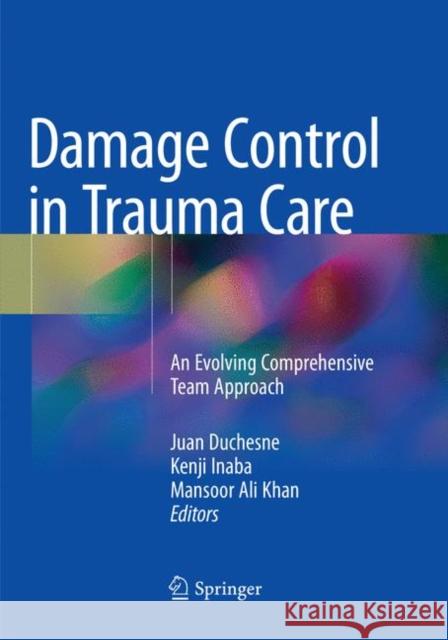Damage Control in Trauma Care: An Evolving Comprehensive Team Approach » książka



Damage Control in Trauma Care: An Evolving Comprehensive Team Approach
ISBN-13: 9783030102357 / Angielski / Miękka / 2018 / 287 str.
Damage Control in Trauma Care: An Evolving Comprehensive Team Approach
ISBN-13: 9783030102357 / Angielski / Miękka / 2018 / 287 str.
(netto: 421,70 VAT: 5%)
Najniższa cena z 30 dni: 424,07
ok. 22 dni roboczych
Dostawa w 2026 r.
Darmowa dostawa!
"This multiauthored book describes the application of damage control techniques for the disciplines involved in contemporary trauma care. ... Providers in emergency medicine, neurosurgery, critical care, orthopedics, and general surgery will find this book helpful. The authors and contributors include leaders in American trauma surgery and a select group of international providers." (David J. Dries, Doody's Book Reviews, August, 2018)
Damage Control Evolution.- Application of Damage Control in Trauma Settings.- Military Damage Control.- Adaptation of Military Damage Control in Civilian Settings.- Role of Pre-hospital Care Providers.- Emergency Department Damage Control.- Damage Control Surgery.- Damage Control Neurosurgery.- Damage Control Orthopedics.- Damage Control Vascular Surgery.- Damage Control Cardiothoracic Surgery.- Critical Care Damage Control.- Anesthesia Damage Control.- Adjuncts of Damage Control.- Resuscitation Evolution: What is damage control resuscitation?- Damage Control in Austere Environments.
Kenji Inaba, MD, FRCSC, FACS is an Associate Professor, Clinical Scholar, of Surgery, Anesthesia and Emergency Medicine at the Keck School of Medicine, University of Southern California, Los Angeles, CA, USA. Dr. Inaba is an attending trauma surgeon at the LAC+USC medical center and is the Vice Chair of Surgery and the Program Director for the Surgery residency and Trauma Critical Care Fellowship at USC. He has authored more than 380 peer reviewed articles, 350 scientific presentations and 27 textbook chapters. He is a member of numerous editorial boards and professional organizations and is currently a director of the American Board of Surgery. Dr. Inaba also serves as a sworn police officer with the LAPD, currently assigned to Rampart Division Patrol.
Mansoor Ali Khan, MBBS, PhD, FRCS, FEBS, FACS, AKC, is a Consultant Military and Trauma Surgeon who has combined work as a Surgeon Commander in the Royal Navy with civilian posts. He is a Consultant Trauma Surgeon at St. Mary’s Hospital in London, and an Honorary Senior Clinical Lecturer at Imperial College London. Dr Khan’s experience has involved work at minimally equipped mobile medical response units at a variety of locations around the world, and he has twice served at Camp Bastion in Afghanistan. He has endeavoured to apply within the NHS environment the skills that he has acquired while working in military contexts. Dr Khan has received several awards and decorations for his military and civilian endeavours). He is an Associate Editor for Trauma (SAGE Publishing), a member of the editorial board for Trauma Journal (SAGE Publishing) as well as serving as a reviewer for several international journals. He is heavily involved in education and research, serving currently as the Course Director for the internationally renowned Definitive Surgical Trauma Skills (DSTS©) Course held at the Royal College of Surgeons of England. He continues to publish extensively in peer-reviewed journal articles.
This book describes current, evidence-based guidelines for damage control interventions across the field of trauma care with the aim of enabling clinicians to apply them to best effect in daily clinical practice. Emphasis is placed on the need for trauma surgeons and their teams to recognize that optimal damage control in severely traumatized patients depends upon the combination of immediate assessment, resuscitation, and correct surgical management. The book opens by examining the evolution of damage control and the very significant impact that military damage control interventions have had on civilian emergency health care through improvements as simple as bandaging and tourniquets. Damage control measures in different specialties, including neurosurgery, orthopedics, vascular surgery, cardiothoracic surgery, anesthesia, and critical care, are then covered in detail. Readers will also find helpful information on a range of other important topics, such as the role of pre-hospital care providers, damage control within the emergency department, adjuncts of damage control, and damage control in austere environments. This book is a ‘must read’ for all clinicians in the trauma field.
1997-2025 DolnySlask.com Agencja Internetowa
KrainaKsiazek.PL - Księgarnia Internetowa









